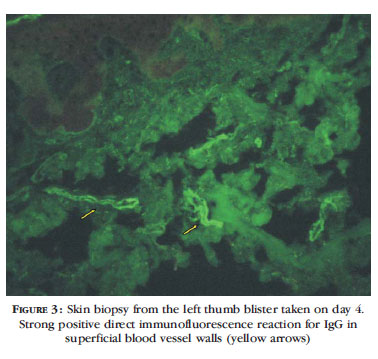Blister formation and eccrine sweat gland necrosis is a cutaneous manifestation associated with states of impaired consciousness, most frequently reported after overdoses of central nervous system depressants, particularly phenobarbital. The case of a 45-year-old woman who developed "coma blisters" at six distinct anatomic sites after confirmed (laboratory) phenobarbital poisoning, associated with other central nervous system depressants (clonazepam, promethazine, oxcarbazepine and quetiapine), is presented. A biopsy from the left thumb blister taken on day 4 revealed focal necrosis of the epidermis and necrosis of sweat gland epithelial cells; direct immunofluorescence was strongly positive for IgG in superficial blood vessel walls but negative for IgM, IgA, C3 and C1q. The patient was discharged on day 21 with no sequelae.
Coma; Fluorescent antibody technique; Microscopy, fluorescence; Phenobarbital; Toxicology




